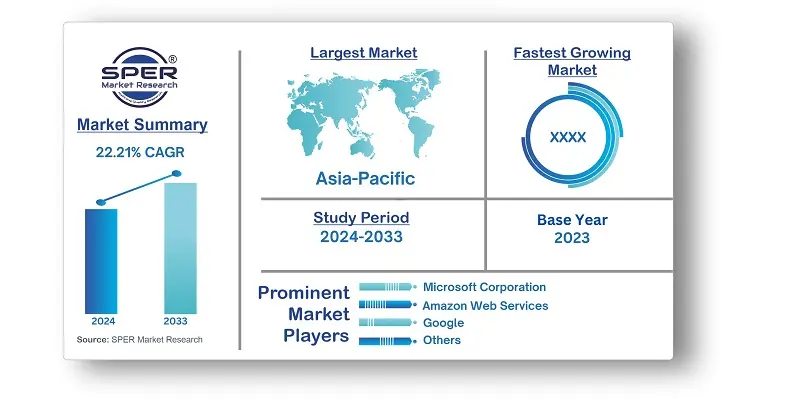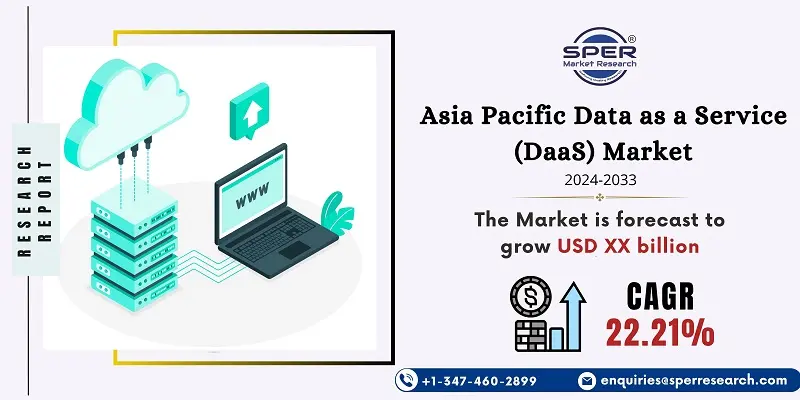
Asia Pacific Data as a Service (DaaS) Market Growth, Size, Trends, Share and Future Outlook
Asia Pacific Data as a Service (DaaS) Market Size- By Development, By Organisation Size, By End User- Regional Outlook, Competitive Strategies and Segment Forecast to 2033
| Published: Jul-2024 | Report ID: IACT24136 | Pages: 1 - 157 | Formats*: |
| Category : Information & Communications Technology | |||
- January 2023: Google Cloud Platform launches BigQuery Omni, a new tool that allows organisations to compare data from on-premises and cloud sources.
- February 2023: Amazon Web Services launches Amazon Managed Data Warehouse for SQL Server, a fully managed solution.
- In March 2023, Microsoft announced the public release of Azure Data Lake Analytics Gen2, a new version of their cloud-based data lake analytics service that promised better speed, scalability, and security.


| Report Metric | Details |
| Market size available for years | 2020-2033 |
| Base year considered | 2023 |
| Forecast period | 2024-2033 |
| Segments covered | By Development, By Organisation Size, By End User |
| Regions covered | China, Japan, India, South Korea, Australia, Indonesia, Others. |
| Companies Covered | Microsoft Corporation, Google, Amazon Web Services, IBM Corporation, Oracle Corporation, Alibaba Group Holding Limited, SAP SE, Teradata Corporation, SAS Institute, Inc, Huawei Technologies Co, Ltd, Bloomberg Finance L.P, IQVIA, TIBCO Software, Thomson Reuters Corporation. |
- Large Enterprises
- Small and Medium-sized Enterprises (SMEs)
- Financial Services Companies
- Healthcare and Life Sciences Organizations
- Retail and E-commerce Businesses
- Telecommunications Providers
- Government and Public Sector Agencies
- IT and Technology Firms
- Media and Entertainment Companies
- Education and Research Institutions
| By Development: |
|
| By Organisation Size: |
|
| By End User: |
|
- Asia Pacific Data as a Service (DaaS) Market Size (FY’2024-FY’2033)
- Overview of Asia Pacific Data as a Service (DaaS) Market
- Segmentation of Asia Pacific Data as a Service (DaaS) Market By Development (Public Cloud, Private Cloud, Hybrid Cloud)
- Segmentation of Asia Pacific Data as a Service (DaaS) Market By Organisation Size (SMEs, Large Enterprises)
- Segmentation of Asia Pacific Data as a Service (DaaS) Market By End Users (BFSI, Healthcare, Retail, IT and Telecom, Government, Others)
- Statistical Snap of Asia Pacific Data as a Service (DaaS) Market
- Expansion Analysis of Asia Pacific Data as a Service (DaaS) Market
- Problems and Obstacles in Asia Pacific Data as a Service (DaaS) Market
- Competitive Landscape in the Asia Pacific Data as a Service (DaaS) Market
- Impact of COVID-19 and Demonetization on Asia Pacific Data as a Service (DaaS) Market
- Details on Current Investment in Asia Pacific Data as a Service (DaaS) Market
- Competitive Analysis of Asia Pacific Data as a Service (DaaS) Market
- Prominent Players in the Asia Pacific Data as a Service (DaaS) Market
- SWOT Analysis of Asia Pacific Data as a Service (DaaS) Market
- Asia Pacific Data as a Service (DaaS) Market Future Outlook and Projections (FY’2024-FY’2033)
- Recommendations from Analyst
1.1. Scope of the report1.2. Market segment analysis
2.1. Research data source
2.1.1. Secondary Data2.1.2. Primary Data2.1.3. SPER’s internal database2.1.4. Premium insight from KOL’s
2.2. Market size estimation
2.2.1. Top-down and Bottom-up approach
2.3. Data triangulation
4.1. Driver, Restraint, Opportunity and Challenges analysis
4.1.1. Drivers4.1.2. Restraints4.1.3. Opportunities4.1.4. Challenges
4.2. COVID-19 Impacts of the Asia Pacific Data as a Service (DaaS) Market
5.1. SWOT Analysis
5.1.1. Strengths5.1.2. Weaknesses5.1.3. Opportunities5.1.4. Threats
5.2. PESTEL Analysis
5.2.1. Political Landscape5.2.2. Economic Landscape5.2.3. Social Landscape5.2.4. Technological Landscape5.2.5. Environmental Landscape5.2.6. Legal Landscape
5.3. PORTER’s Five Forces
5.3.1. Bargaining power of suppliers5.3.2. Bargaining power of buyers5.3.3. Threat of Substitute5.3.4. Threat of new entrant5.3.5. Competitive rivalry
5.4. Heat Map Analysis
6.1. Asia Pacific Data as a Service (DaaS) Market Manufacturing Base Distribution, Sales Area, Product Type6.2. Mergers & Acquisitions, Partnerships, Product Launch, and Collaboration in Asia Pacific Data as a Service (DaaS) Market
7.1. Asia Pacific Data as a Service (DaaS) Market Size, Share and Forecast, By Development, 2020-20267.2. Asia Pacific Data as a Service (DaaS) Market Size, Share and Forecast, By Development, 2027-20337.3. Public Cloud7.4. Private Cloud7.5. Hybrid Cloud
8.1. Asia Pacific Data as a Service (DaaS) Market Size, Share and Forecast, By Organisation Size, 2020-20268.2. Asia Pacific Data as a Service (DaaS) Market Size, Share and Forecast, By Organisation Size, 2027-20338.3. SMEs8.4. Large Enterprises
9.1. Asia Pacific Data as a Service (DaaS) Market Size, Share and Forecast, By End User, 2020-20269.2. Asia Pacific Data as a Service (DaaS) Market Size, Share and Forecast, By End User, 2027-20339.3. BFSI9.4. Healthcare9.5. Retail9.6. IT and Telecom9.7. Government9.8. Others
10.1. Asia Pacific Data as a Service (DaaS) Market Size and Market Share
11.1. Asia Pacific Data as a Service (DaaS) Market Size and Market Share By Region (2020-2026)11.2. Asia Pacific Data as a Service (DaaS) Market Size and Market Share By Region (2027-2033)11.3. China11.4. Japan11.5. India11.6. South Korea11.7. Australia11.8. Indonesia11.9. Others
12.1. Microsoft Corporation
12.1.1. Company details12.1.2. Financial outlook12.1.3. Product summary12.1.4. Recent developments
12.2. Google
12.2.1. Company details12.2.2. Financial outlook12.2.3. Product summary12.2.4. Recent developments
12.3. Amazon Web Services
12.3.1. Company details12.3.2. Financial outlook12.3.3. Product summary12.3.4. Recent developments
12.4. IBM Corporation
12.4.1. Company details12.4.2. Financial outlook12.4.3. Product summary12.4.4. Recent developments
12.5. Oracle Corporation
12.5.1. Company details12.5.2. Financial outlook12.5.3. Product summary12.5.4. Recent developments
12.6. Alibaba Group Holding Limited
12.6.1. Company details12.6.2. Financial outlook12.6.3. Product summary12.6.4. Recent developments
12.7. SAP SE
12.7.1. Company details12.7.2. Financial outlook12.7.3. Product summary12.7.4. Recent developments
12.8. Teradata Corporation
12.8.1. Company details12.8.2. Financial outlook12.8.3. Product summary12.8.4. Recent developments
12.9. SAS Institute, Inc
12.9.1. Company details12.9.2. Financial outlook12.9.3. Product summary12.9.4. Recent developments
12.10. Huawei Technologies Co Ltd
12.10.1. Company details12.10.2. Financial outlook12.10.3. Product summary12.10.4. Recent developments
12.11. Bloomberg Finance L.P
12.11.1. Company details12.11.2. Financial outlook12.11.3. Product summary12.11.4. Recent developments
12.12. IQVIA
12.12.1. Company details12.12.2. Financial outlook12.12.3. Product summary12.12.4. Recent developments
12.13. TIBCO Software
12.13.1. Company details12.13.2. Financial outlook12.13.3. Product summary12.13.4. Recent developments
12.14. Thomson Reuters Corporation
12.14.1. Company details12.14.2. Financial outlook12.14.3. Product summary12.14.4. Recent developments
12.15. Others
SPER Market Research’s methodology uses great emphasis on primary research to ensure that the market intelligence insights are up to date, reliable and accurate. Primary interviews are done with players involved in each phase of a supply chain to analyze the market forecasting. The secondary research method is used to help you fully understand how the future markets and the spending patterns look likes.
The report is based on in-depth qualitative and quantitative analysis of the Product Market. The quantitative analysis involves the application of various projection and sampling techniques. The qualitative analysis involves primary interviews, surveys, and vendor briefings. The data gathered as a result of these processes are validated through experts opinion. Our research methodology entails an ideal mixture of primary and secondary initiatives.



Frequently Asked Questions About This Report
PLACE AN ORDER
Year End Discount
Sample Report
Pre-Purchase Inquiry
NEED CUSTOMIZATION?
Request CustomizationCALL OR EMAIL US
100% Secure Payment






Related Reports
Our Global Clients
Our data-driven insights have influenced the strategy of 200+ reputed companies across the globe.




















